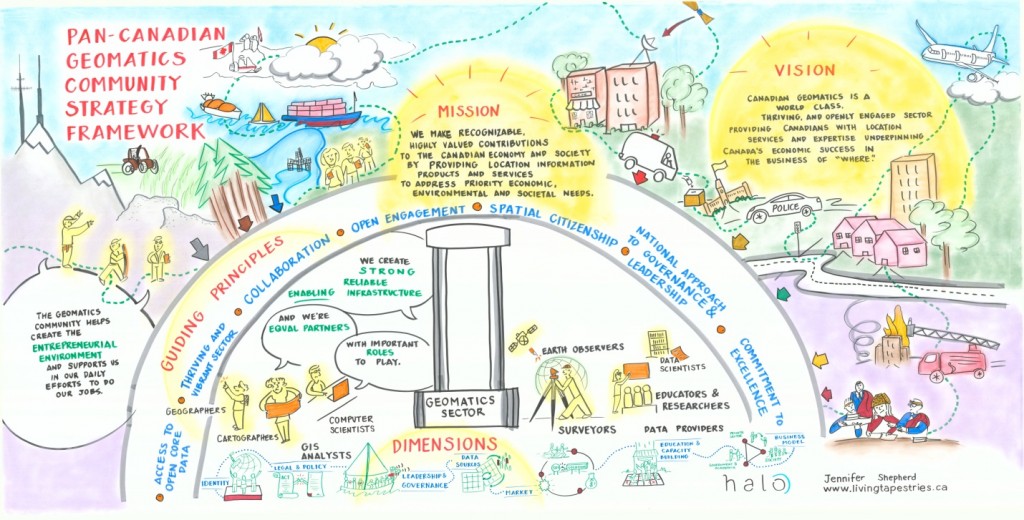
On March 22nd, GoGeomatics Toronto hosted an event where a group of passionate and interested students assembled to explore the main issues affecting their future in the Canadian geomatics sector. Each member of the group, including myself, came from a different academic background so they were able to provide their own unique perspective, insight, and concerns.
Our student group discussed the Pan-Canadian Geomatics Draft Strategy, which was developed by the Canadian Geomatics Community Round Table (CGCRT) in order to examine common issues and to present a coast-to-coast plan to reposition the sector for future success. As students we explored one dimension of the Strategy in particular – which focuses on ‘Education and Capacity Building’ and how that relates to students and new professionals at the college and university level. As well this dimension is particularly concerned with ensuring a geospatially-enabled society by making sure the broader geospatial community has the skills necessary to make effective use of geospatial information in their daily work.
One of the first issues we identified is the lack of awareness of geomatics among the general population. General awareness could be generated by connecting geomatics to current issues and providing easy to access educational opportunities about the ways in which geomatics is used in day-to-day life. While this is a significant issue, it is undoubtedly difficult to force any person to develop an interest in an industry or subject matter unfamiliar to them. As such, it may be more important to switch focus from the general public and target decision/policy makers, young students, and entrepreneurs. By targeting these key components of the population, the value of geomatics in decision-making, service providing, application building, research, etc. can be emphasized, and in turn, indirectly impact the more general population – which could be just as effective, if not more, as targeting them directly as a whole.
While developing a future geospatially-enabled society is important, one of the issues discussed by our student group was the development of a comprehensive and relevant education, training, and professional development framework for building a skilled geomatics workforce. The group strongly agreed that in order to reach this objective, collaboration between academia, industry, government, and the various geomatics associations is imperative. Perhaps it is important for key industry players to have a role in developing academic curricula and training programs for young geomatics professionals in order to ensure that programs are aligned with the changing needs of the sector.
This could also provide a way to address the large mismatch between the industry and developing opportunities. Many new graduates are finding that most of the entry-level jobs in our sector are not geared toward entry-level workers. This is yet another instance in which collaboration between academia and industry would be of the utmost importance. It is also important to consider introducing any developed academic programs to high-school students, as well as those in university/college, as another way to increase awareness and promote geomatics as a viable academic and professional route for younger students.
Partnerships that allow for industry input in education and training programs could also assist with the issue of harmonizing geomatics accreditation across the sector. This was a topic that was particularly difficult for the group to reach a consensus on. It led to a riveting discussion surrounding the idea of creating a license or exam in order to be considered a “Geomatics Professional”. Some members of the group supported this idea, as it would assist with meeting the objective of having geomatics recognized as a viable professional brand in Canada by adding legitimacy and equality to the industry. Other members strongly objected to the idea because of the broad nature of the geomatics industry. Some stated that they would not be willing to pay a fee to be a licensed professional, which may also deter younger students from choosing to enter the sector – directly impacting the future of the geomatics workforce. Though a consensus was not reached, it is agreed that this issue, as well as the others described above, are among crucial topics that need to be addressed when planning for the best future for Canadian Geomatics. What are your thoughts concerning this issue? We would love to hear them.
One last item to note. The idea of a Canadian Geospatial Student Union was also brought up. A student and young professional organization focused on moving students from the classroom to the workplace. This would be of great benefit to the community and we hope it finds some traction in the months and years ahead.
Our group submitted the results of our discussion to the CGCRT in the form of a word doc. We hope that other students and groups will do the same.
Thank you to the students who took part in this important discussion. Your insight and feedback are greatly appreciated by GoGeomatics Canada and will hopefully be taken into consideration when the next iteration of the Pan-Canadian Geomatics Strategy comes out soon.
I will be attending the national leaders debate on the Strategy on June 9th-10th in Ottawa. I’ll have with me all of our ideas and concerns raised during our group meeting and be a representative for our unique student perspective on current, and future, national issues that affect us.





Be the first to comment